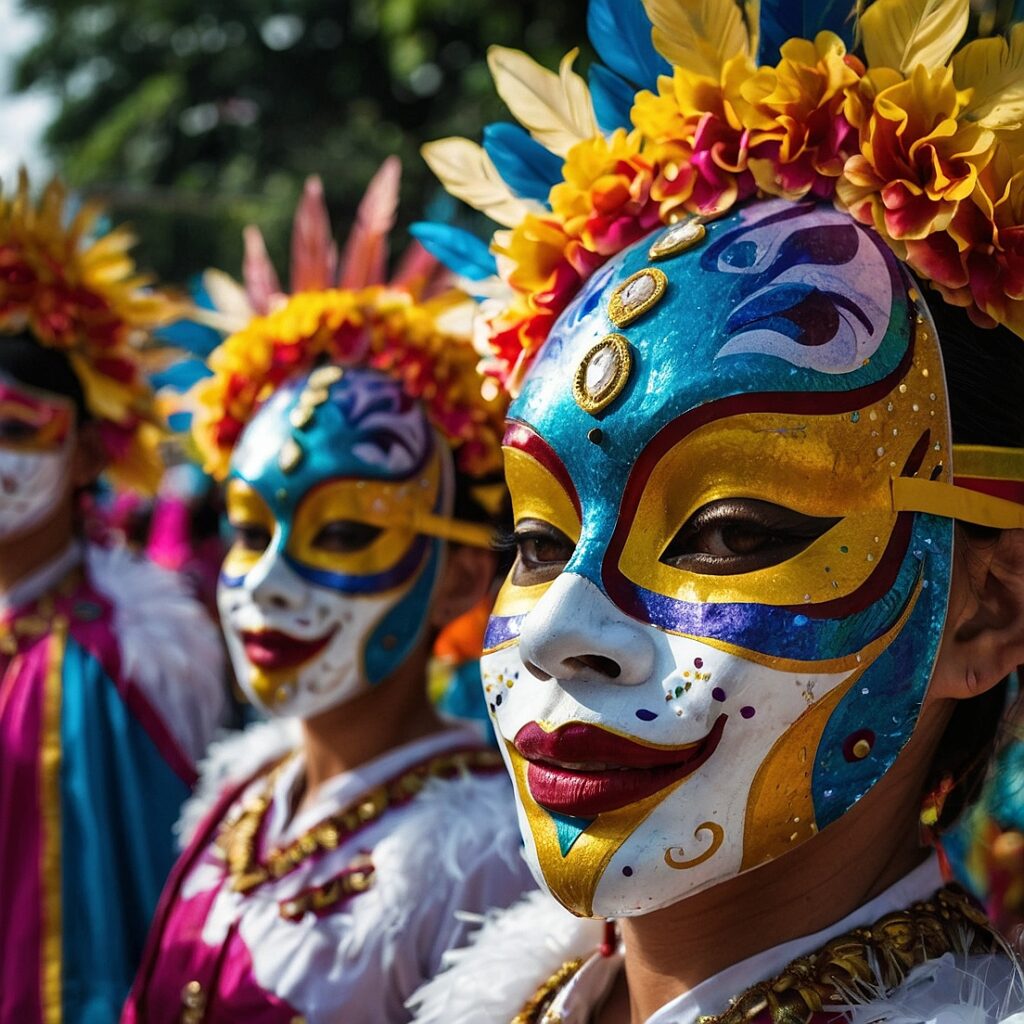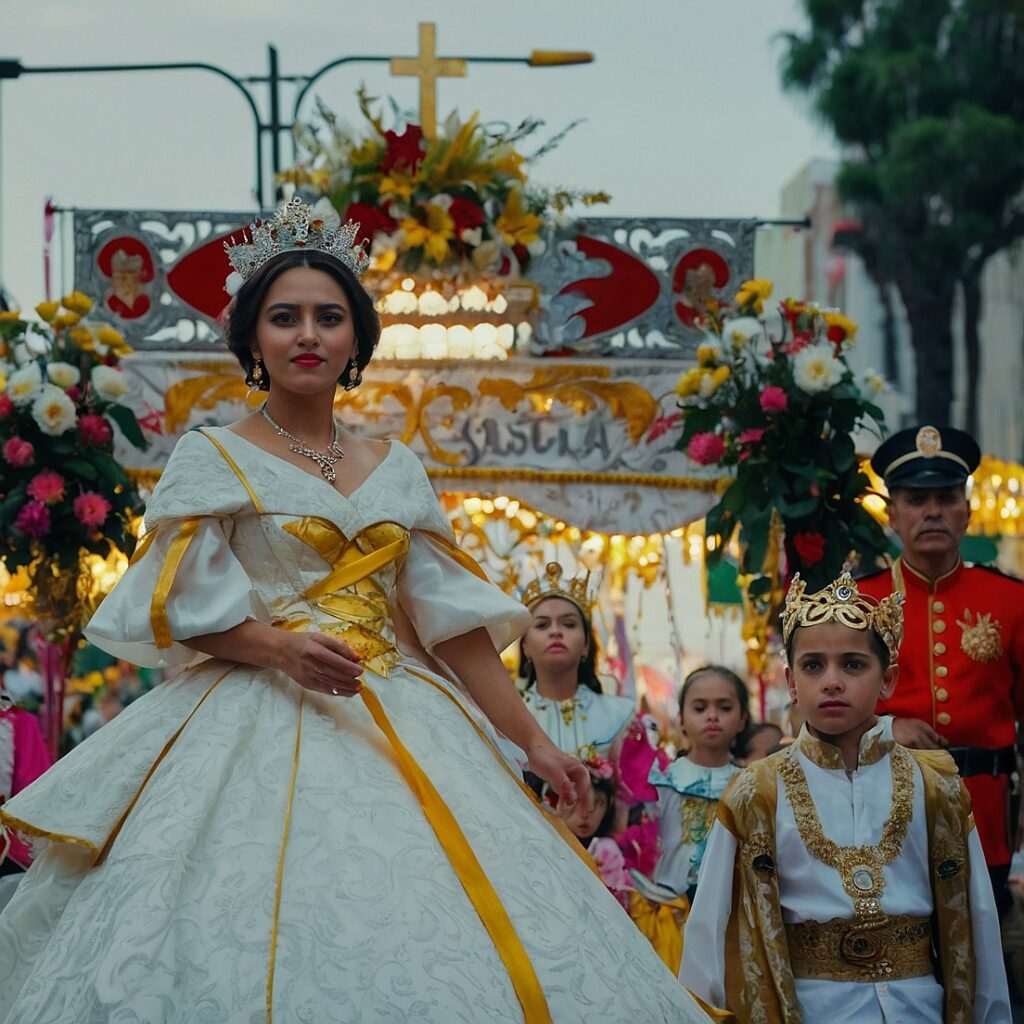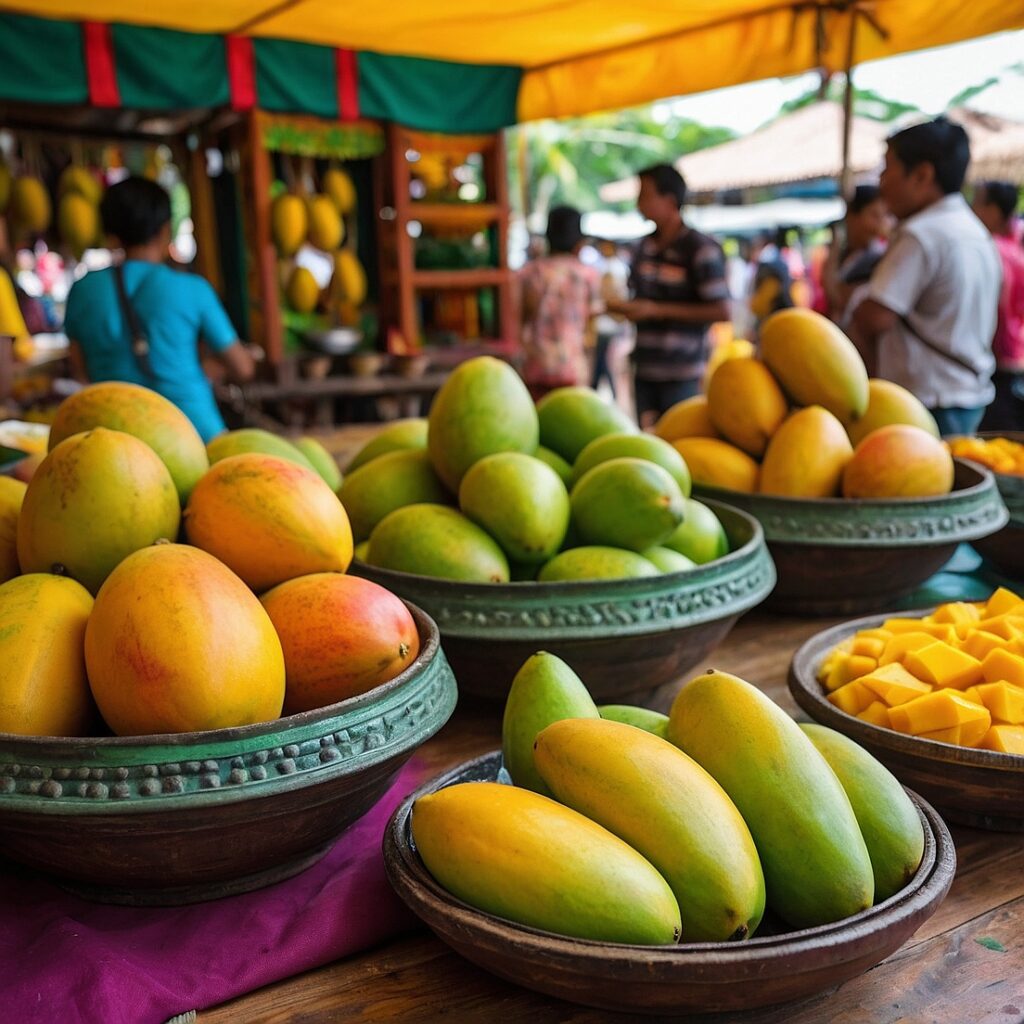Have you ever heard of a festival that was born out of tragedy but became a symbol of resilience and joy? Welcome to the MassKara Festival, the vibrant celebration that has put Bacolod City on the global cultural map. Picture this: a sea of smiling masks, elaborate costumes bursting with color, and the infectious rhythm of street dancing. That’s the MassKara Festival for you – a feast for the senses and a testament to the indomitable spirit of the Bacoleños.
Let’s dive into the fascinating world of this unique Filipino festival, affectionately known as the “Festival of Smiles.” We’ll explore its rich history, the intricate preparations that go into it, and why it has become a must-see event for locals and tourists alike. So, grab a cup of coffee (or better yet, a glass of Bacolod’s famous fresh lumpia shake), and let’s embark on this colorful journey together!
The Origins: Rising from the Ashes of Adversity
A Tale of Two Tragedies
The story of the MassKara Festival is one of triumph over adversity. It all began in 1980, a year that brought double tragedy to the people of Bacolod. The sugar industry, the lifeblood of Negros Occidental province, was facing a severe crisis. Sugar prices had plummeted, leaving many families in economic turmoil. As if this wasn’t enough, on April 22 of the same year, the inter-island vessel MV Don Juan collided with a tanker and sank, claiming the lives of hundreds, including many Negrenses.
In the face of these hardships, the people of Bacolod could have succumbed to despair. Instead, they chose to smile. The city’s artists, local government, and civic groups came together with a brilliant idea: to create a festival of smiles. This festival would not only lift the spirits of the people but also showcase the resilience and creativity of Bacolod to the world.
The Birth of MassKara
The name “MassKara” is a clever play on words. It’s a combination of “mass” (a multitude of people) and the Spanish word “cara,” meaning face. Put together, it sounds like “maskara,” the Filipino word for “mask.” This wordplay captures the essence of the festival – a mass celebration featuring smiling masks.
The first MassKara Festival was held in October 1980. It was a modest affair compared to today’s grand spectacle, but it achieved its goal of bringing smiles back to the faces of Bacoleños. The festival coincided with the city’s charter day celebrations, making October a month of double joy for Bacolod.
The Evolution: From Local Celebration to Global Phenomenon
Growing in Scale and Popularity
What started as a local effort to boost morale has, over the years, transformed into one of the Philippines’ most anticipated festivals. The MassKara Festival has grown in scale, attracting visitors from all over the country and even international tourists. Let’s take a look at how the festival has evolved over the years:
| Year | Milestone |
|---|---|
| 1980 | First MassKara Festival held |
| 1988 | Introduction of the street dance competition |
| 1994 | MassKara Queen beauty pageant added to the festivities |
| 2002 | Electric MassKara parade introduced |
| 2016 | MassKara Festival recognized as one of the country’s best tourism events |
The festival has not only grown in size but also in duration. What was once a weekend affair now spans several weeks, usually culminating on the fourth Sunday of October. This extended celebration gives more people the chance to experience the magic of MassKara.
International Recognition
The MassKara Festival’s fame has spread far beyond the shores of the Philippines. It has been featured in international media and has even represented the Philippines in tourism expos around the world. In 2019, the festival was showcased at the Kyoto International Film and Art Festival in Japan, bringing the vibrant spirit of Bacolod to an international audience.
The festival’s growing international profile has not only boosted tourism in Bacolod but has also become a source of pride for Filipinos worldwide. It’s a colorful testament to the creativity, resilience, and joie de vivre of the Filipino people.
The Masks: The Heart and Soul of MassKara
Crafting Smiles
At the core of the MassKara Festival are the masks – vibrant, elaborate creations that never fail to evoke wonder and joy. These masks are more than just decorative pieces; they’re works of art that embody the spirit of the festival. Each mask features a big, beaming smile, symbolizing the Bacoleños’ ability to stay positive even in the face of adversity.
The creation of these masks is a labor of love that involves skilled artisans and weeks of painstaking work. Traditional materials like papier-mâché are combined with modern elements like plastic and fiberglass to create masks that are both beautiful and durable. The designs often incorporate elements of Bacolod’s culture and history, from indigenous patterns to symbols of the sugar industry.
Evolution of Mask Designs
Over the years, the designs of MassKara masks have evolved, reflecting changing artistic trends and technological advancements. Here’s a brief overview of this evolution:
| Era | Mask Characteristics |
|---|---|
| 1980s | Simple designs, primarily made of papier-mâché |
| 1990s | More elaborate designs, introduction of feathers and sequins |
| 2000s | Incorporation of LED lights for the Electric MassKara |
| 2010s | Use of lightweight materials, more intricate and diverse designs |
Despite these changes, one thing remains constant: the radiant smile that adorns each mask. It’s this smile that captures the essence of the festival and the spirit of the Bacoleño people.
The Dance: Rhythms that Move the Soul
A Spectacle of Movement and Color
If the masks are the heart of MassKara, then the dance is its soul. The street dance competition is one of the most anticipated events of the festival, featuring groups of dancers in elaborate costumes moving to pulsating Latin beats mixed with local rhythms. It’s a spectacle that captivates all who witness it, a riot of color and movement that embodies the joy and energy of the festival.
The MassKara dance is no simple affair. Performers spend months rehearsing complex choreographies that tell stories of Bacolod’s history and culture. The dance moves often mimic the swaying of sugarcane in the wind, paying homage to the crop that has long been the backbone of the local economy.
The Evolution of MassKara Dance
Like other aspects of the festival, the MassKara dance has evolved over the years:
| Period | Dance Characteristics |
|---|---|
| Early 1980s | Simple folk-inspired movements |
| Late 1980s-1990s | Introduction of Latin influences |
| 2000s | More acrobatic elements, larger group formations |
| 2010s onwards | Incorporation of contemporary dance styles, elaborate production numbers |
Despite these changes, the essence of the dance remains the same – a joyous celebration of life and resilience, performed with beaming smiles hidden behind colorful masks.
The Festival Experience: More Than Just Masks and Dance
A Feast for All Senses
While the masks and street dancing are the most iconic elements of MassKara, the festival offers so much more. It’s a multi-faceted celebration that engages all the senses. The air is filled with the aroma of local delicacies, the sound of music echoes through the streets, and everywhere you look, there’s a feast of colors and spectacles.
Food lovers will find themselves in paradise during MassKara. Bacolod, known as the “City of Smiles,” could just as easily be called the “City of Good Eats.” The festival is the perfect time to indulge in local specialties like chicken inasal (grilled chicken marinated in local spices), kansi (beef soup), and the famous Napoleones (a layered pastry with sweet filling).
Events Galore
The MassKara Festival calendar is packed with events catering to various interests. Here’s a snapshot of some popular activities:
| Event | Description |
|---|---|
| MassKara Queen Pageant | A beauty contest showcasing the grace and talent of local women |
| Electric MassKara | A nighttime parade featuring dancers with LED-lit costumes |
| Food festivals | Showcasing the best of Bacolod’s culinary scene |
| Art exhibits | Displaying works by local artists |
| Sports events | Including fun runs and boxing matches |
| Concert series | Featuring both local and national music acts |
These diverse events ensure that there’s something for everyone at MassKara, whether you’re a foodie, an art enthusiast, a music lover, or simply looking for a good time.
The Economic Impact: Boosting Bacolod’s Economy
A Boon for Local Businesses
The MassKara Festival isn’t just a cultural celebration; it’s also a significant economic event for Bacolod City. The influx of tourists during the festival period provides a substantial boost to the local economy, benefiting a wide range of businesses from hotels and restaurants to souvenir shops and transportation services.
According to local government data, the festival attracts hundreds of thousands of visitors each year, with numbers steadily increasing. Let’s look at some figures:
| Year | Estimated Visitors | Estimated Economic Impact |
|---|---|---|
| 2015 | 210,000 | PHP 350 million |
| 2016 | 230,000 | PHP 400 million |
| 2017 | 250,000 | PHP 450 million |
| 2018 | 280,000 | PHP 500 million |
| 2019 | 300,000 | PHP 550 million |
These figures demonstrate the festival’s growing economic importance to Bacolod City. It’s worth noting that these numbers represent direct spending and don’t account for the long-term benefits of increased tourism visibility for the city.
Employment and Skill Development
The MassKara Festival also creates numerous employment opportunities, both temporary and long-term. From artisans crafting masks and costumes to event organizers, security personnel, and tour guides, the festival generates jobs across various sectors.
Moreover, the festival has spurred the development of local crafts and skills. The demand for high-quality masks and costumes has led to the growth of a cottage industry of artisans who work year-round to prepare for the festival. This has not only preserved traditional crafts but also encouraged innovation in design and materials.
The Cultural Significance: Preserving Heritage Through Celebration
A Mirror of Bacolod’s Identity
The MassKara Festival is more than just a tourist attraction; it’s a vital part of Bacolod’s cultural identity. Through its vibrant displays and performances, the festival tells the story of Bacolod – its history, its struggles, and its triumphs. It serves as a living, evolving testament to the city’s resilience and creativity.
The festival has become a platform for preserving and showcasing local traditions. From the intricate designs of the masks that often incorporate indigenous motifs to the dance performances that blend traditional and contemporary styles, MassKara is a celebration of Bacolod’s rich cultural heritage.
Fostering Community Spirit
One of the most significant impacts of the MassKara Festival is how it brings the community together. The preparations for the festival involve people from all walks of life – from school children participating in dance competitions to senior citizens volunteering in various capacities. This collective effort fosters a strong sense of community pride and unity.
The festival also serves as a homecoming event for many Bacoleños who have moved away. Many plan their visits to coincide with MassKara, reinforcing family ties and connections to their hometown. In this way, the festival plays a crucial role in maintaining Bacolod’s social fabric.
The Future of MassKara: Adapting to Changing Times
Embracing Technology
As we look to the future, it’s clear that the MassKara Festival will continue to evolve. One of the most significant changes in recent years has been the incorporation of technology into the festivities. The Electric MassKara parade, with its dazzling light displays, is just one example of how the festival is embracing modern innovations.
There’s also been a growing focus on digital promotion and engagement. Social media has become an integral part of the festival experience, with organizers leveraging platforms like Facebook and Instagram to reach a global audience. Virtual reality tours of the festival have even been discussed as a potential future development, allowing people from around the world to experience the magic of MassKara from afar.
Sustainability Initiatives
Another important aspect of MassKara’s future is a growing emphasis on sustainability. Festival organizers have begun implementing measures to reduce the event’s environmental impact, such as promoting the use of eco-friendly materials in costume and mask production and implementing better waste management practices during the festivities.
There’s also been a push to make the economic benefits of the festival more sustainable and widely distributed. Initiatives to support local artisans and small businesses, not just during the festival period but year-round, are being developed.
The Enduring Legacy of MassKara
As we’ve explored in this journey through the vibrant world of the MassKara Festival, this celebration is so much more than just a tourist attraction. It’s a powerful symbol of resilience, a showcase of creativity, a driver of economic growth, and a keeper of cultural heritage.
Born out of adversity, the MassKara Festival has grown into a phenomenal celebration that captures the heart and soul of Bacolod City. It’s a testament to the power of community, the importance of preserving culture, and the unbreakable spirit of the Filipino people.
Whether you’re a culture enthusiast, a food lover, a dance aficionado, or simply someone who enjoys a good celebration, the MassKara Festival has something for you. It’s an experience that will leave you with a smile on your face and warmth in your heart – much like the smiling masks that have become the enduring symbol of this remarkable festival.
So, why not start planning your trip to Bacolod for the next MassKara Festival? Come and be part of this joyous celebration, and discover for yourself why Bacolod truly deserves its title as the “City of Smiles.”
Disclaimer: This article was written based on information available up to 2020. While we strive for accuracy, some details may have changed since then. We encourage readers to check the latest information from official sources when planning their visit. If you notice any inaccuracies, please report them so we can promptly make corrections.




